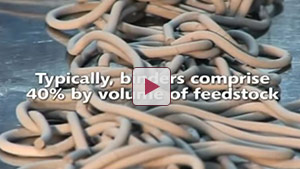Introduction to Powder Metallurgy
What is powder metallurgy? Powder metallurgy is a metal-forming process performed by heating compacted metal powders to just below their melting points. Although the process has existed for more than 100 years, over the past quarter century it has become widely recognized as a superior way of producing high-quality parts for a variety of important applications. This success is due to the advantages the process offers over other metal forming technologies such as forging and metal casting, advantages in material utilization, shape complexity, near-net-shape dimensional control, among others. These, in turn, contribute to sustainability, making powder metallurgy a recognized green technology.
The images in Figure 1 include a complex planetary carrier for a four-wheel drive torque transfer system, a helical gear and blades of stainless steel used in laparoscopic surgical scissors, a manifold weighing over 6.5 tons used on an offshore oil platform, and a steel connecting rod used in V-8 engines. All of these components were made using powder metallurgy.
Powder Metallurgy Technologies
In reality, powder metallurgy comprises several different technologies for fabricating semi-dense and fully dense components. The conventional powder metallurgy process, referred to as press-and-sinter, was used to produce the planetary carrier shown here. The surgical scissor parts were formed through the metal injection molding (MIM) process, the manifold was manufactured through hot isostatic pressing (HIP), while the connecting rod was produced using powder forging (PF). Meanwhile, new to the scene, metal additive manufacturing (AM) is gaining popularity.
Using many of these PM processing techniques, as well as other processes such as spray forming, roll compaction, rapid solidification, and others, components are also produced today from particulate materials other than metal powders. Today's advanced materials are seldom made of metals and metallic alloys alone, often incorporating ceramics, ceramic fibers, and intermetallic compounds. These include:
- cermets
- intermetallic compounds
- metal matrix composites
- nanostructured materials
- high-speed steels
Powder metallurgy is an integral part of our lives.
To learn more about this metal-forming process watch:
Powder Metallurgy Touches Your Life
 Powder Metallurgy: The Preferred Metal-Forming Solution, showcases the fabrication capabilities of the various technologies known collectively as powder metallurgy (PM). Built on the theme, "Every day, in some way, PM touches your life," the two-part video uses dozens of examples of actual components manufactured for many different applications to illustrate the benefits PM offers parts designers and engineers.
Powder Metallurgy: The Preferred Metal-Forming Solution, showcases the fabrication capabilities of the various technologies known collectively as powder metallurgy (PM). Built on the theme, "Every day, in some way, PM touches your life," the two-part video uses dozens of examples of actual components manufactured for many different applications to illustrate the benefits PM offers parts designers and engineers.
Watch Powder Metallurgy Touches Your Life, Part 1 on YouTube.
Watch Powder Metallurgy Touches Your Life, Part 2 on YouTube.
Metal Injection Molding Touching Your Life
 This video, in two parts, showcases the fabrication capabilities of the various technologies known collectively as powder metallurgy (PM), with particular focus on metal injection molding. Part 1 of the program uses dozens of examples of actual components manufactured for many different applications to illustrate the benefits all the various PM technologies offer parts designers and engineers.
This video, in two parts, showcases the fabrication capabilities of the various technologies known collectively as powder metallurgy (PM), with particular focus on metal injection molding. Part 1 of the program uses dozens of examples of actual components manufactured for many different applications to illustrate the benefits all the various PM technologies offer parts designers and engineers.
Part 2 of the program describes the metal injection molding process, providing design engineers with all the facts needed to understand why, if they're designing an intricate metal part, they should think of MIM from the start.
Watch Metal Injection Molding Touches Your Life, Part 1 on YouTube.
Watch Metal Injection Molding Touches Your Life, Part 2 on YouTube